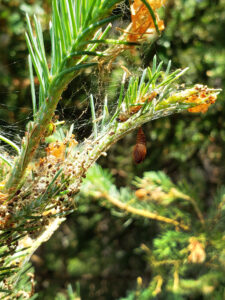By Linda Williams, DNR Forest Health Specialist, Woodruff;
Linda.Williams@wisconsin.gov or 920-360-0665

Webbing created by the spruce budworm caterpillar holds needles and frass and protects the caterpillar. A pupa hangs from the branch. / Photo Credit: Linda Williams, Wisconsin DNR
Although symptoms weren’t as prevalent as in 2023, this year marked yet another year of defoliation from spruce budworm.
Another severe year of defoliation causes additional stress on the trees. Even though there has been a lot of rainfall this spring, it’s still stressful for the trees to face repeated years of defoliation by spruce budworm before they begin to decline and die.
Spruce budworm is a native insect with periodic outbreaks that defoliate spruce and balsam fir. Caterpillars were feeding early this spring; they then pupated and moths emerged to mate and lay eggs. So, the damage is done for the year. The caterpillars created webbing and defoliation becomes noticeable as clipped needles stuck in the webbing turn rusty red.
Outbreaks occur every 30-50 years, and each outbreak lasts for an average of 10 years. Our previous outbreak ran from 1970-1980, and our current outbreak began approximately in 2012. Unfortunately, it appears populations are still going strong, and we are unsure when the population will collapse again. Whether climate change plays a role in outbreak duration is unknown.

Defoliation can make trees look brown and eventually grey as the dead foliage washes off the tree. / Photo Credit: Linda Williams, Wisconsin DNR
Mature balsam fir and spruce are preferred hosts, although younger trees can be defoliated as well. Repeated defoliation causes top-kill and can eventually cause whole-tree mortality. Balsam fir stands, or stands with a heavy component of balsam fir, often are more severely impacted.
After three years of significant defoliation or additional years of lighter defoliation, dieback may be seen in the tops of trees. If trees are missing more than 75% of their needles, or if the stand has been heavily defoliated for more than three years (including the current year), salvage harvests should be considered to capture value from affected trees and remove dead trees.
Homeowners with just a few spruce or fir trees to protect can treat them with insecticide. The biological insecticide Btk, as well as general insecticides, can be sprayed on the new needles early in the spring to control the caterpillars.
Defoliation is often most severe in the upper portions of the tree, so homeowners should plan accordingly to make sure the entire tree is treated. Tree care companies may have equipment that can reach to the top of trees. Treatments need to take place early in the spring when the caterpillars are still small. In Wisconsin, that means treatments generally need to take place in early to mid-May.
